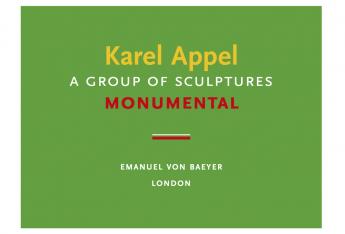Appel Cover
Emanuel von Baeyer Ltd
'Karel Appel. Monumental: A Group of Sculptures'
English text. 32 pages, 26 illustrations.
The sculptures in this collection are the very first examples of works that are described in the oeuvre as the ‘third period of sculpture’. They are statement of his ideas and imagery, each a kind of ‘Gesamtkunstwerk’ that is, architecture, painting and sculpture combined. They are constructivist as well as expressionist and reveal a classic sense of dignity in their proportions. They were created at the same time as the poetry paintings series in conjunction with Allen Ginsberg and Gregory Corso.
Playing with found objects is not unusual in art and with this Appel began his sculpture making in 1947. This was five years after Pablo Picasso’s incunable Bull’s Head, created in 1942 from the seat and handlebars of a bicycle. It is described as Picasso’s most famous discovery, a simple yet “astonishingly complete” metamorphosis. Picasso’s highpoint in regard to found objects was reached in La Chèvre (The Goat), 1950 and in the bronze work, Baboon and Young, 1951 which featured a match-box car as the baboon’s head. Appel, in his late twenties, was contemporaneous with Picasso by then. With his sculpture Spider, 1991 he even took up the motif a few years in advance of his contemporary Louise Bourgeois, which was to become her main subject in her later sculptural work from 1994 onwards.
With Spider, Appel picked up transforming found objects again almost half a century after his first attempts at sculpting. Through his experience and with the ease that a world-famous artist could now afford, he refined his first method. For him, “These objects [were] not a goal in themselves, but a means of taking a detour from familiar trodden path in order to arrive at a new images”.
And so a toilet tank is turned over and becomes the base of the Cat Standing On A Head. All sorts of wooden parts were piled freely and carelessly on top of each other and, after some contemplation, declared to be an altar. The King’s Altar, 1991, constructed from wooden chairs, tables and a ladder, was a precursor to a new series that Appel explicitly referred as “Pyres” (Brandstapels). They have a remarkable material and conceptual range to them. The altar is reminiscent of shrines found in rural churches that were decorated with various popular, devotional objects.
In 1989 Appel bought the Villa Licia near Mercantile and converted it into a studio to spend his summers in, whilst also building a studio in Connecticut at the same time. In the groups of work of the early 90s, an extraordinary productive period, comparing Appel’s work between the two studios. When the work was created in the new- build Connecticut studio, the artwork appeared “almost without exception, entirely painted and less robust in character. ... They are compiled from materials that come from all kinds of sources and that Appel did not combine in order to turn them into new forms, but placed alongside one another, each with equal weight. He referred to theses works as ‘Hybrid Art’.... The Tuscan sculptures evolved by combining materials found in the immediate environment. They are simpler and more spatial in nature and their materials have retained their original character. These sculptures seem naturally suited to public space. The combination of the demanded by the materials and the history of the place from which they came show that Tuscany was an environment that occupied Appel, an influence that he clearly intended to reveal in his work.
Contact us via our website to enquire about purchasing the catalogue: https://www.evbaeyer.com/
Spécialités
- Art
- History of printing
- Prints and drawings

